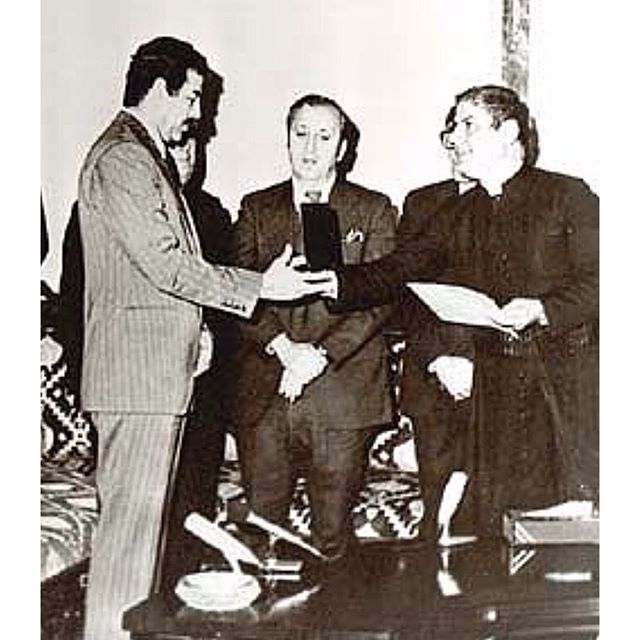Taken in 1862 during the American Civil War, then Lieutenant George A. Custer sits with his men in the 2nd U.S. Cavalry:
Now here’s the colorized version:
Taken in 1862 during the American Civil War, then Lieutenant George A. Custer sits with his men in the 2nd U.S. Cavalry:
Now here’s the colorized version:
A short video about the very first Air Force One, Columbine II.
Enjoy!
The first plane to be designated as Air Force One now sits in a southern Arizona field that’s part of Marana Regional Airport.
The aircraft that once spirited President Dwight D. Eisenhower on cross-country voyages is nearly forgotten on a 10-acre parcel, decaying under the relentless glare of the sun.
“I think it’s one of these big secrets that, really, few people know that it’s out there,” airport manager Steve Miller told The Arizona Daily Star. “It’s sad that it’s just sitting out there, considering its history over the past 70 years.”
The original Air Force One is a Lockheed VC-121 Constellation 48-610 that was built in California in 1948. The next year it was converted to carry VIPs and re-designated as a VC-121A.
It was named Columbine II after the state flower of Colorado, the home state of first lady Mamie Eisenhower.
In 1953 it became the official presidential aircraft until it was replaced in 1954, when it became the primary backup aircraft.
After a brief civilian stint with Pan American, the aircraft carried Eisenhower for a final time on Oct. 25, 1959, on a trip from Augusta, Ga., to Washington, D.C.
It served as a VIP transport at Washington National Airport and Maryland’s Andrews Air Force Base before it was retired and flown to Davis-Monthan Air Force Base in 1968. It was stripped of its identity and fitted with mismatched landing gear.
Mel Christler of Christler Flying Service bought the aircraft, along with four others, in a 1970 surplus auction, not knowing its true identity. He hoped to convert it to an aerial sprayer, but the plane would not fly due to the landing gear problem.
The United States got its nickname, Uncle Sam on September 7th 1813, The name is linked to Samuel Wilson, a meat packer from Troy, New York, who supplied barrels of beef to the United States Army during the War of 1812. Wilson (1766-1854) stamped the barrels with “U.S.” for United States, but soldiers began referring to the grub as “Uncle Sam’s.” The local newspaper picked up on the story and Uncle Sam eventually gained widespread acceptance as the nickname for the U.S. federal government.
In the late 1860s and 1870s, political cartoonist Thomas Nast (1840-1902) began popularizing the image of Uncle Sam. Nast continued to evolve the image, eventually giving Sam the white beard and stars-and-stripes suit that are associated with the character today. The German-born Nast was also credited with creating the modern image of Santa Claus as well as coming up with the donkey as a symbol for the Democratic Party and the elephant as a symbol for the Republicans. Nast also famously lampooned the corruption of New York City’s Tammany Hall in his editorial cartoons and was, in part, responsible for the downfall of Tammany leader William Tweed.
Perhaps the most famous image of Uncle Sam was created by artist James Montgomery Flagg (1877-1960). In Flagg’s version, Uncle Sam wears a tall top hat and blue jacket and is pointing straight ahead at the viewer. During World War I, this portrait of Sam with the words “I Want You For The U.S. Army” was used as a recruiting poster. The image, which became immensely popular, was first used on the cover of Leslie’s Weekly in July 1916 with the title “What Are You Doing for Preparedness?” The poster was widely distributed and has subsequently been re-used numerous times with different captions.
In September 1961, the U.S. Congress recognized Samuel Wilson as “the progenitor of America’s national symbol of Uncle Sam.” Wilson died at age 88 in 1854, and was buried next to his wife Betsey Mann in the Oakwood Cemetery in Troy, New York, the town that calls itself “The Home of Uncle Sam.”

File this under Only in America.
Did you know that Saddam Hussein was awarded the key to the city of Detroit in 1980?
Saddam Hussein directed hundreds of thousands of dollars to a church in Detroit and ended up receiving a key to the city for more than two decades. This is after he became the president of Iraq. Saddam’s bond with Detroit started in 1979 with Reverend Yasso congratulating him on his presidency. The church received a sum of $250,000. Post this donation, Yasso referred to Saddam as a kind, generous and cooperative person. He later on reported that money and power changed the person.
Saddam’s relationship with the United States changed suddenly post the coalition from 1980-88 with Iraq. Yasso said he presented Saddam with the key to the city, courtesy of then-Mayor Coleman Young. It is then when Yasso got a surprise. Saddam donated another $200,000 when he found out there was a debt on their church.